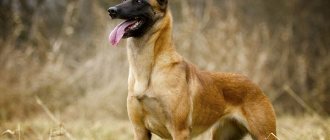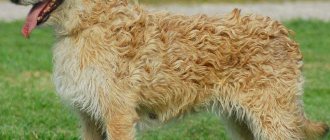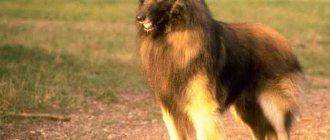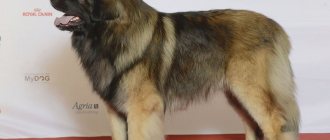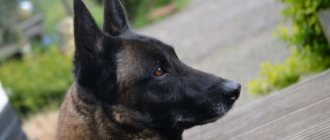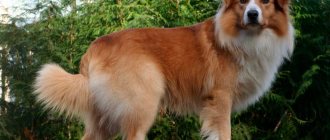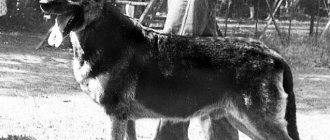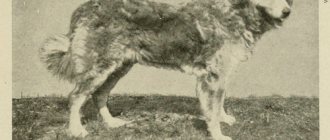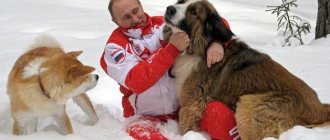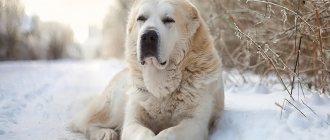| Origin | Belgium |
| Usage | Security guards; shepherds |
| Color | Shades of red color; on the face the mask is a darker shade than the main color. |
| Dimensions | Height (cm) 56-65; male Malinois weight (in kg) 27-30, females from 20 to 26 kg. |
| Lifespan | up to 14 years old. |
In search of a reliable and faithful friend, you should look at the Belgian Shepherd and become familiar with the subtleties of character and behavior. Belgian Shepherds are divided into four subspecies: Malinois, Tervuren, Groenendael, Laekenois. Separately, the Malinois is noted as an example of fidelity and grace. The ability to learn allows it to be used in such areas as rescue and search work, service in law enforcement agencies.
Breed standard
The Belgian Malinois is a harmoniously developed animal with a proportional build. The original breed standard, dated 1892, was set uniformly for all Belgian Shepherds: one species, varying in coat type. It was only in 1907 that a decision was made to divide the Belgians into 4 subspecies, differing in coat type and color: Malinois (short-haired); Laekenois (wire-haired); Groenendael and Tervuren (long-haired).
The table below describes the Malinois breed standards.
| Options | Description |
| Head | Elongated shape. The length of the muzzle is equal to the length of the head. |
| Frame | Powerful yet lightweight. The height at the withers is equal to the length of the body. |
| Muzzle | Elongated wedge-shaped. The nose is black, the nostrils are wide. |
| Ears | Triangular ears with strong cartilage, point straight up. |
| Neck | Muscular, elongated, widening towards the shoulders. |
| Eyes | Almond-shaped eyes, non-protruding, from light brown to dark chocolate color. |
| Bite | Scissor-shaped or pincer-shaped. |
| Malinois colors | Red coat color all over the body with a dark mask on the muzzle. Dark overlay - each hair at the tip is colored black, spread throughout the body. |
| Wool | Short, dense, harsh with medium undercoat. |
| Tail | Thick at the base, tapering towards the tip. Saber-shaped, not rising above the level of the body. |
| Limbs | The forelimbs are powerful, with well-developed bones. Not twisted. The hind limbs are muscular and strong. |
| Paws | The fingers are gathered into a ball, the claws are dark and hard. |
| Movements | The movements are active, more running in a circle than in a straight line. All limbs move at the same level, without standing out. |
Signs according to which rejection occurs:
- Increased aggression or cowardice.
- Undershot or overshot.
- Drop ears.
- Tail docked at birth or during life.
- Curling tail.
- No mask on the face.
- White spots on the body.
Each dog has a unique mask, which can be seen in the photo of the Malinois shepherd dog.
Character and working qualities of the Malinois
The Malinois is highly intelligent, responsive, very attached to its owner, highly efficient and extremely energetic. Today, all debates about the working qualities of the Malinois are irrelevant. They are indispensable in the police, rescue services, customs and other canine structures of all countries of the world. In addition, they defeat German shepherds in IPO, perform in agility and mondjoring, where they have no equal, as well as in obedience, Russian ring, dog dancing and other canine sports. Well, and, of course, they play the role of pets. Malinois love all members of their family very much, are easy to train, and unpretentious in maintenance. But the Malinois owner must be correct and moderately strict, and also have enough time and a great desire for regular exercise with his dog. The Malinois was created to serve man, this breed is very hardy and energetic, without work it suffers greatly and can become a source of problems. It doesn't matter what you do with this dog, as long as it has something to do! Although working with them undoubtedly requires high professionalism from the trainer... All over the world there is a clear division of dogs of this breed into working and show dogs. When selecting working dogs, breeders pay attention exclusively to working qualities - good grip, rigidity in work, flair, and so on, but the beauty of the dog - chiseled head, square format, correctly set tail - does not play any role for them. Working Malinois have exceptional qualities that allow them to become increasingly popular in many countries around the world, and in recent years they have gradually replaced other working breeds. They are distinguished by their excellent learning ability, activity and speed, plasticity, absence of problems with hip dysplasia, excellent protective qualities - strong grip, agility, passion. But today 99.9% of these dogs do not have show qualities. (And thank God! Editor's note) In Belgium, most nurseries and breeders breed working Malinois, and only a few nurseries specialize in show dogs.
Excerpts from the standard. Belgian Shepherd. General impression. The Belgian Shepherd is a dog with a harmonious build. She combines grace and power. Medium size, dry and strong proportional build, square format. Adapted to outdoor maintenance, resistant to changes in weather and atmospheric phenomena characteristic of the Belgian climate in which it was bred. With the harmony of its forms and the high carriage of its head, the Belgian Shepherd creates the impression of elegant strength, which has become the property of the selection of this working breed. At exhibitions must be judged in a free standing position without physical contact with the handler. Important proportions. Square dog. The chest should be lowered to the level of the elbows. The length of the muzzle is equal to or slightly longer than half the length of the head. Behavior/Character: The Belgian Shepherd is an alert and at the same time active dog, always ready for action. Since this dog is a herding dog (guardian of herds), it includes all the best qualities of a guard dog. She must have a lively temperament and a confident character, without cowardice or aggression. At shows, the judge will give his preference to a dog with a calm and courageous character. Head: Carried high, of medium length, chiseled and dry. The length of the skull and muzzle is approximately the same, but the muzzle is slightly longer than the skull, which gives the impression of completeness. Muzzle : Medium length, chiseled under the eyes, gradually tapering towards the nose; the line drawn from the forehead to the nose is straight and parallel to the line of the forehead; the corners of the lips are drawn back. Jaws/Teeth : Strong and white teeth set in well-developed jaws. Scissor bite, level bite is acceptable. For a herding dog, a pincer bite is preferred. Set of teeth, the absence of the first two premolars is allowed (2 PM1); and the absence of a third molar (M3) is not taken into account. Eyes : medium size, not deep set, but not protruding. The eye shape is almond-shaped, the eye color is brown, preferably dark brown. The edges of the eyelids are black. The look is lively, direct, intelligent. Ears: rather small, set high, triangular in shape, the ears are rounded at the base. Neck: Slightly elongated, dry, muscular, blending smoothly into the shoulders; the occipital part slightly resembles an arc. Body: powerful, but not heavy. The length of the body from the shoulder to the rear point of the thigh is approximately equal to the height at the withers. Chest: not wide, but dropped; When viewed from the front, it is not wide, but not narrow either. Tail: strong at the base, of medium length, in a calm state the dog carries it downwards, while its tip is curved slightly upward and should reach the level of the hock joint. When in motion it is more elevated. Also, it should not be bent with a hook or bent to the side. Forelegs: Strong but not heavy boned; Muscular, lean and strong, they should be perfectly parallel when viewed from the front. The shoulder blades are long and inclined, attached flatly, forming an angle with the humerus, which ideally is 110-1150. Paws . Almost round in shape; fingers are brought together and tightly clenched; The pads are thick and elastic, the claws are dark and strong. Hindquarters : Powerful but not heavy, they should be perfectly parallel when viewed from behind. Movement: Lively, free, not constrained. Constantly on the move, the Belgian Shepherd seems tireless. Due to its boisterous temperament, the Belgian Shepherd has a habit of moving in circles rather than in a straight line. COAT . The length of the coat and its structure are different among Belgian Shepherds; these differences formed the basis for dividing the breed into varieties. There are four varieties of the Belgian Shepherd: Groenendael, Tervuren, Malinois, Laekenois. In all variants, the coat should be thick, dense, of good structure, with a silky undercoat to provide excellent protection from adverse weather conditions. The Malinois is a short-haired variety with very short hair on the head, outer surface of the ear and on the underside of the legs. Short on the rest of the body. More hair on the tail and around the neck where it forms a collar. On the back sides of the hind legs the hair is longer. The hair on the tail is very thick and slightly longer than on the body. Color: Uniform red with charcoal and a black mask. The Malinois' mask should cover the lips (upper and lower) and eyelids in one black area. The red color should be warm, neither light nor washed out. White color is acceptable on the chest and fingers.
DIMENSIONS, WEIGHT: Ideal height at the withers: - for a male 62 cm, for a female 58 cm; The allowed difference is from -2 to +4 cm. Weight: - for a male 25-30 kg, for a female 20-25 kg; Since 1974, breeding between Belgian Shepherd varieties has been prohibited by the FCI.
Literature. 1. Les Bergers Belges. Philippe De Waily, Andre Varlet. Solar 1994. France 2. Le Malinois. Marie-France Varlet-Dewaele. PB Editions. 1999. France 3. I cani da Pastori Belgi. Angelo Tavazzani. Edizioni Cinque.1997. Italy 4. New encyclopedia of dogs. Eva-Maria Kremer. Moscow. Aquarium. 2004
read more Malinois in Russia and abroad
Author of the article Olga Shilova Head of the Belgian Shepherd section of the CLRS "GARD" since 1997, RKF expert on working qualities. The article is posted with the permission of the author. Copying is prohibited.
Character
The Malinois has a balanced character. He is vigilant, not timid, and has innate protective qualities. Obedience and affection make him a loyal friend and companion. A lively and active dog needs an equally energetic owner. Without physical exercise, the Malinois can become aggressive, because the historical purpose of the shepherd requires a burst of energy. With proper upbringing, he becomes a full member of the family, a friend for children.
The Belgian Malinois is able to accurately recognize a person’s mood and the atmosphere in the house.
Will not tolerate rude treatment, indifference is a real punishment for the Belgian. Does not strive to be the dominant one in the family; he considers the owner to be the center of the Universe. The main characteristic of the breed is determination and efficiency.
Character and behavioral characteristics
Belgian Malinois have a complex and difficult temperament. Intelligence, endless devotion and helpfulness are combined with independence and autonomy. Without proper training, pets will ignore the owner's orders.
Important! The dog is attached to the owner, obeys only him, easily capturing moods and emotions. He is wary of strangers and easily fights back when a threat arises.
On a walk
Attitude towards children
Animals get along better with teenagers, but they don’t pay attention to kids. They will not allow a familiar attitude, but will protect the child under the direct order of the owner. Pets are hiding from the annoying baby.
Important! Dog handlers do not recommend leaving any dog and children alone; adults should supervise their interactions.
Security and guard qualities
Malinois are among the best defenders and watchmen; they will never leave their post if they are ordered to guard a house or territory. Robbers will not pass by such a defender, and you don’t have to worry about the safety of your property.
Skills training for protective guard service
Application
The Belgian Malinois is a hardy, strong animal. Adapted to various weather conditions, it is not afraid of rain, heat or cold. The Malinois is considered the most adapted to harsh conditions compared to other Belgians. After all, dogs were originally bred to help herd and guard livestock. Over time, these qualities improved, and the most productive individuals were selected for further breeding. Such qualities as resistance to stress, sociability, and gentleness were valued.
Modern Belgian Malinois dogs are divided into two groups: working dogs and ring participants. Working dogs are used in the service of law enforcement agencies. Their help in searching for missing people, in police service, and security is invaluable. Ring dogs are also hard workers, but in a different direction. Participation in sports competitions and exhibition shows fully demonstrates the dog’s capabilities.
History of the breed
Herding dog breeds, due to their working qualities, have always been popular in regions where cattle breeding was developed. The Netherlands and Belgium were no exception, on the border of which short-haired shepherds grazed herds, which later became the ancestors of the Belgian shepherds.
At the end of the 19th century, the naturally formed breed was somewhat improved by crossing to obtain the desired qualities. As a result of the work of canine specialists, 4 main breeds of Belgian Shepherds were developed from almost 40 varieties: Groenendael, Laekenois, Malinois and Tervuren. They differed in the type and color of their coat. In 1891, the National Belgian Shepherd Union was founded.
Handsome purebred
In 1898, the first Belgian Malinois club was opened. The name of the breed was given by the small town of Mechelen, which in French sounds like Malin. In 1901, the Malinois breed was included in the Pedigree Book of Belgium.
Nowadays, Belgian Shepherds serve in the police and army of many countries. They successfully cope with complex tasks of searching for people and dangerous objects, and in everyday life they help protect property and livestock, and also work as guides.
Socialization
Socialization is the level of a dog’s comfortable state of health in a particular setting or situation. If a Malinois dog lives in an urban environment, then such qualities as not being afraid of city noise, transport, lack of aggression towards large numbers of people, and an indifferent attitude towards stray dogs and cats are instilled.
The dog requires early socialization to develop its character, otherwise it will grow up suspicious and aggressive.
Animals in rural areas need to be socialized more than their urban counterparts. Especially if the dog is planned to be exhibited in the future. A Malinois sitting behind a fence, not seeing anyone except members of the household, will not be able to behave adequately in the ring if it finds itself in an unfamiliar environment.
The first activities are carried out after scheduled vaccinations. They begin to take the puppy to quiet places. Each time they increase the walking area, introducing them to new surroundings. Once the puppy has established contact with its owner, you can move on to the next stage—meeting other dogs and people.
Interesting facts about Belgian Shepherds
The list includes the following indicators:
- pets are considered one of the best guards;
- need daily active walks;
- serious animals do not know how to play with children;
- to avoid aggression and disobedience, early socialization and education are required;
- The owner needs a strong character and experience in communication - the animal is not suitable for beginners.
Important! Belgian Shepherds almost went extinct during the First World War.
Beginners often confuse the main breed with the dwarf or small shepherd dog from Belgium - the Schipperke. Its small size does not prevent it from looking like an ordinary service dog, and its volume makes it easy to get along in the smallest apartments.
Tervuren with long hair
How to choose a puppy
When choosing a puppy for an exhibition, you should prefer those nurseries that can boast of achievements in exhibition activities. Future ring champions and participants in various show programs are bred here.
A decent breeder is always ready to make contact with the future owner of the puppy, will tell you everything about the Malinois breed, and give advice on care and maintenance. The main condition is that the puppy, like his mother, must look healthy: moderately well-fed, eyes, nose and ears free of purulent discharge. The coat should cover the entire body evenly, without bald spots. A healthy puppy has a good appetite, so it’s worth trying (with the breeder’s permission) to feed him.
The baby goes to a new home at the age of 8-9 weeks. At this point, the first series of scheduled vaccinations has already been done, and the puppy has begun to try “adult” food. To prevent the Malinois puppy from being sad, you need to take with you something with the smell of its mother: a bedding or some other rag. This makes it easier for him to cope with the stress of moving.
It is not recommended to buy a puppy secondhand at bird markets or through private advertisements. No one will give any guarantees regarding breed and health status.
A Brief Overview of the Advantages and Disadvantages of Malinois Shepherd Dogs
The advantages of the Malinois breed include the following:
- By purchasing a Malinois puppy, you become the owner of a guard breed, this is genetically inherent in them;
- one of the main qualities of the Malinois is observation and caution;
- dogs of this breed are smart and sociable, they will certainly become your reliable companions and friends, and will invariably accompany you wherever you go;
- thanks to their high intelligence, Malinois are easy to train, they understand their owner literally, they serve faithfully and devotedly, and they are strict with strangers;
- These dogs are quite friendly towards children, although dog handlers warn that they should not be left alone with children;
- good trainability and caution make this breed indispensable as a service dog - experts recommend accepting them for service in the Ministry of Emergency Situations even more often than German shepherds;
- Malinois are very hardy, have excellent health and do not require special care.
Among the disadvantages of the breed, most of which, however, can be regarded as advantages, we highlight the following:
- Malinois is a very active dog that requires space and an active lifestyle; it can hardly tolerate being in closed spaces and needs frequent walks and training;
- dogs of this breed really need communication, so long separations from the owner are not for them;
- you should treat with great care the interaction of Malinois with small children: animals may accidentally miscalculate their strength and harm them;
- Malinois require constant training: not only physical, but also intellectual;
- These dogs shed twice a year, and in apartment conditions almost constantly, so it is necessary to care for their coat.
Features of maintenance and care
Shepherds are working dogs. It is better to keep them in a private house with a spacious yard or area where the dog can run freely. They adapt well to living in city apartments. In this case, the owner must devote more time to walking the pet. The peculiarity of the breed is that a Malinois sitting idle for too long can become irritable and aggressive.
Grooming
Grooming procedures can be carried out at home, which significantly saves the family budget.
- Grooming
The Malinois' coat is easy to care for - comb out during shedding with a fine-toothed comb, and periodically wipe the surface of the entire body with a damp cloth. These manipulations are enough.
- Nail care
Trim as it grows. Usually once every 2-3 weeks.
- Ear care
Once a week, wipe the inside surface from dust and dirt. During the period of tick activity, inspection for their presence is necessary. A dog that spends most of its time outside is examined daily. To treat an animal against parasites, sprays are used that repel ticks and other blood-sucking insects.
Bathing
The dog was bred to live outside, so it does not need frequent bathing. It is enough to wash once every 3 months. Its fur has dirt-repellent properties. Of course, when you come back from a walk in rainy weather, you wash your paws. The animal is accustomed to this procedure from early childhood. In summer, swimming in open water is recommended; there are no restrictions. Malinois usually love to swim in the river or sea.
Walk
In order not to lose physical shape, the animal needs long walks and significant physical activity. The Malinois needs this vitally. Loves ball games, frisbee (games with a flying disc), agility (overcoming various obstacles). Any active actions delight the Belgian. You won't find a better companion for long hikes.
Feeding
Proper nutrition from an early age will allow you to raise a healthy and harmoniously developed dog. The Malinois needs a balanced diet that will satisfy the animal's need for all nutrients. Overfeeding, as well as underfeeding, may in the future result in problems with metabolism and the functioning of the reproductive system.
An adult dog is fed twice a day. Products included in the Malinois' natural diet:
- Meat.
- Roots.
- Cereals.
- Fermented milk products.
- Fish.
With a natural diet, you need to periodically provide a multivitamin supplement.
The drinking regime is calculated based on the dog's needs. An adult dog has 40 grams of water per 1 kg of animal weight. Young animals need 80-90 grams of fluid per 1 kg of weight.
Eating industrial food (dry, canned) gives confidence that the pet is fully provided with all the vitamins and nutrients that fully satisfy the dog’s needs. The value of ready-made dry food is that it is easily selected according to the dog’s age, and also corrects emerging diseases.
Classification of dry food:
- For puppies.
- For adult animals.
- For nursing bitches.
- For older dogs.
- Hypoallergenic food.
- Food that improves digestion.
Care and maintenance
The presence of a Belgian Shepherd in the home requires compliance with certain hygiene rules. Remember that you should not bathe it too often, as even special dog shampoos can ruin the animal’s fur. The coat may lose its characteristic stiffness and dullness. The fact is that the Belgian Shepherd's coat should not be too silky and shiny.
If you want to get rid of the characteristic dog spirit, use commercially available products, trying to use them as sparingly as possible. Also avoid bathing puppies under one year of age, as they may catch a cold.
It is necessary to regularly dry brush the wool. A comb for combing a Belgian Shepherd should have fairly wide teeth so as not to pull out hairs of the coat and undercoat. The comb must be moved slowly and only through the wool. The brush, in turn, should be hard, but not very thick.
An adult should be brushed once a week, a puppy – twice a week. But under no circumstances should you cut your dog's hair, as this will give the Belgian Shepherd a non-standard look and the coat will no longer grow to the desired length. Grooming also serves to prevent infection. The fact is that ticks, fleas and itches can grow between the hairs of the fur and on the skin. The ears, eyes and nose are cleaned with a cotton swab dipped in warm water.
The Belgian Shepherd needs space. And if after sunset it makes sense to keep her at home, then during the day she is against it. It is advisable to let her be in the open air, providing her with shelter from wind and rain in advance.
Health
The Belgian Malinois is considered one of the healthiest breeds: it is suitable for outdoor living and is not susceptible to colds. With proper care, a dog can live up to 14-15 years, while maintaining its working qualities for up to 10-12 years.
Diseases
Common diseases include food allergies. Also, due to improper nutrition and lack of exercise, the dog may become obese.
Vaccinations
Routine vaccinations are required for Malinois just like all dogs. No animal is immune from such life-threatening diseases as plague and rabies. Vaccinations performed strictly according to an individual schedule will reduce the risk of disease.
The first standard manipulations are carried out at 2 months of age. The puppy is first treated for fleas and worms: the presence of parasites can negate the effectiveness of vaccinations. In the table below you can see the planned immunization activities.
| Disease | Vaccination procedure | Revaccination | Next vaccination |
| Rabies | 12-13 weeks | At 12 months | Annually |
| Hepatitis | The first vaccination is at 8-10 weeks, the second after 3-4 weeks. | At 12 months | Annually |
| Plague | The first vaccination is at 8-10 weeks, the second after 3-4 weeks. | At 12 months | Annually |
| Parvovirus | The first vaccination is at 8-10 weeks, the second after 3-4 weeks. | At 12 months | Annually |
| Microsporia | 1-6 months | In 2 weeks | Annually |
Training a Malinois puppy in
When you turn to our canine center for help in training a Malinois puppy, you can be sure that a real specialist in his field
and will provide training at the proper, highest level.
- A dog trainer will come to your
home at a time convenient for you. - Classes are held 1-2 times a week
, depending on the program. - Instructors work from 9:00 to 21:00
, on weekends inclusive - The training program is drawn up at the first lesson,
taking into account the breed, age, personal characteristics of the dog and your wishes for training - Some classes take place at home
, some
outside
, depending on the topic of the lesson. - Puppy age
from 2 months
Our Center employs dog handlers - animal psychologists who have experience in working with Malinois puppies and training adult dogs from 10 to 35 years old, who know all the nuances of their behavior
and features of training at each stage of a dog’s growth. Therefore, your pet is guaranteed to learn to carry out your commands the first time in any conditions, and will become your faithful and reliable companion.
Mating
The best age for the first mating of both a female and a male is 1.5-2 years. To find a suitable partner, contact the nursery. There you can choose the best copy. The dogs are walked before the meeting; there is no need to feed them. The “bride” arrives at the “groom’s” territory. Malinois usually knit on their own and do not need human help. To consolidate the result, it is recommended to repeat mating after 1-2 days.
Matings between different types of Belgian Shepherds are prohibited.
How much do Malinois puppies cost?
To purchase a puppy with a good pedigree, you should contact a nursery. The price for working dog puppies will range from 35 to 50 thousand rubles. For puppies intended for show shows, the price can reach 60 thousand rubles.
Sometimes puppies appear in nurseries with traces of defects, due to which the dog cannot participate in exhibitions and breeding in the future. Such puppies are given away almost for nothing. If you need a dog to guard your home, or just as a friend, without plans for a show future, then you can take it without a pedigree.
Nurseries
Malinois (Belgian Shepherd) is the most popular dog for service in the police and army, in disaster medicine units. Thanks to its high sense of smell, it is the best assistant in searching for people and detecting narcotic and illegal substances. A dog whose life without work is impossible. Malinois puppies purchased from professional nurseries have every chance of becoming ring champions.
Vyatkina nursery https://working-malinois.com/
Service dog nursery https://www.freiwind.ru/index.html
Faithful, selflessly devoted, ready to come to the rescue at any moment, and at the same time affectionate dog - the most suitable description of the Malinois breed. An ideal companion for sporty and socializing people.
Malinois character
The dog is very responsive, she is distinguished by high intelligence, so it is always interesting to be with her. She is very affectionate towards her owner, although she adores all family members. Unusually energetic and capable of long-term work, easy to train and unpretentious in maintenance - this is the Malinois. But she requires as much attention from the owner as his desire to exercise regularly with her. She loves to follow commands, even tricks. He does it easily and with great pleasure.
Without work, she gets bored and can turn into an inexhaustible source of problems for the family. They are divided into working dogs and show dogs. For the first, working qualities are important: flair, good grip, good learning ability, speed and activity. And beauty is a secondary issue. For show dogs, on the contrary, beauty is first and foremost important. But, nevertheless, any Malinois is spoken of as a dog that combines power and grace. She can live in an apartment, but she can adapt well to life on the street; she is not afraid of weather surprises.
Looking at her, one gets the impression of an elegant strength: a chest lowered to the level of the elbows and a beautiful muzzle with the most intelligent eyes of medium size, which are neither protruding nor deep-set. The gaze of these almond-shaped eyes is direct and lively. This active, but at the same time vigilant dog is always ready for action. Her movements are not constrained, they are lively, so one gets the impression of the tirelessness of a Malinois. The coat, as it should be on Belgian Shepherds, is thick, dense, and of good structure. There is also a silky undercoat, which is excellent protection from bad weather. But, unlike its relatives of other varieties, it is short throughout the entire body, and especially on the lower part of the limbs, the outer side of the bridle, and the head. It is longest on the neck and tail, on the hind legs (on the inside).
The ideal height for an adult male is 62 centimeters, for females - 58. Their weight is 25-30 kilograms and 20-25 kg, respectively. The Malinois is widespread today in Russia, Belgium, France, the USA, and Finland. Here they are frequent participants in various shows. The dog has a unique nervous system that allows it to work in different roles. In the world, this breed is perhaps the most jumping, so even obstacles more than three meters high are not a problem for them. The dogs are excellently trained, combat-ready, and resistant to stress. And at the same time, she is an excellent companion and family dog. They “don’t complain about their health”, they get sick extremely rarely, they are undemanding when it comes to nutrition and eat little.
If you follow all care recommendations, the dog will live up to fifteen years. Hereditary diseases are not typical for them, there is no tendency to dysplasia of the elbow and hip joints, and it is extremely rare for them to have gastric volvulus. Caring for the wool is very simple: there is no need to wash it at all, even for those who participate in exhibitions. It is only necessary to comb the coat regularly, especially when the shedding period begins.
Interesting stories
In 2021, which is considered the year of the dog according to the Chinese calendar, a short film “A New Year's Story Told by a Malinois” was prepared. The main role is given to this wonderful dog, and the story is told from her perspective. The film was created with the participation of the Russian National Guard film studio.
photo of dog
Another example from the film career of four-legged Belgians. In 2015, the film “Max” was released, telling about the difficult fate of the Malinois. While serving in Afghanistan, he loses his friend and partner Kyle. After suffering stress, the dog cannot perform combat missions, and the military believes that the animal must be euthanized. But Kyle's family decides to take Max for themselves. This film is about how Max learns to exist in a world without bombings and shootings, about friendship and loyalty.
